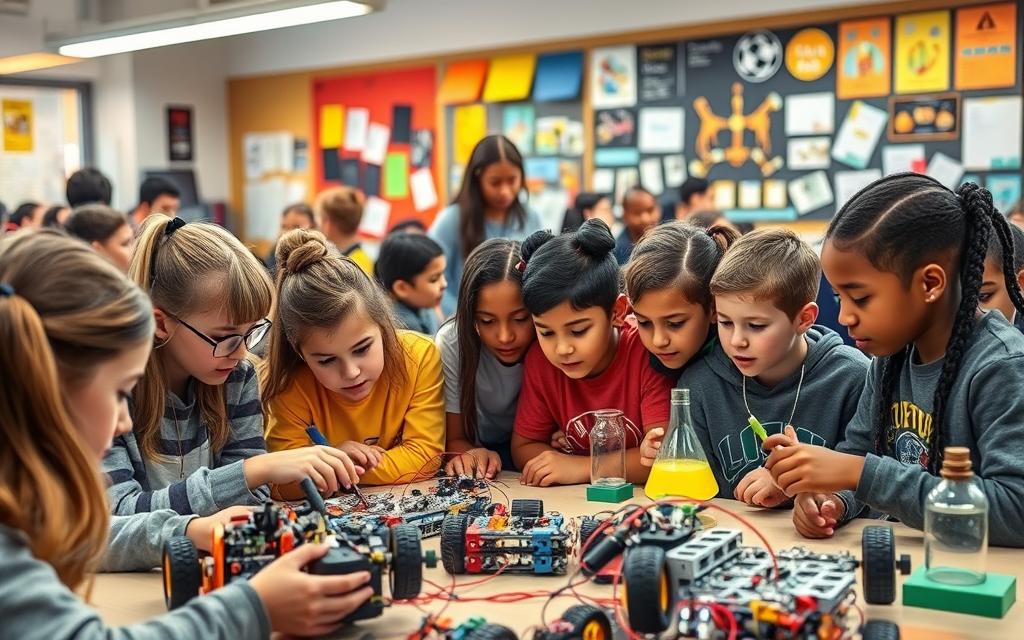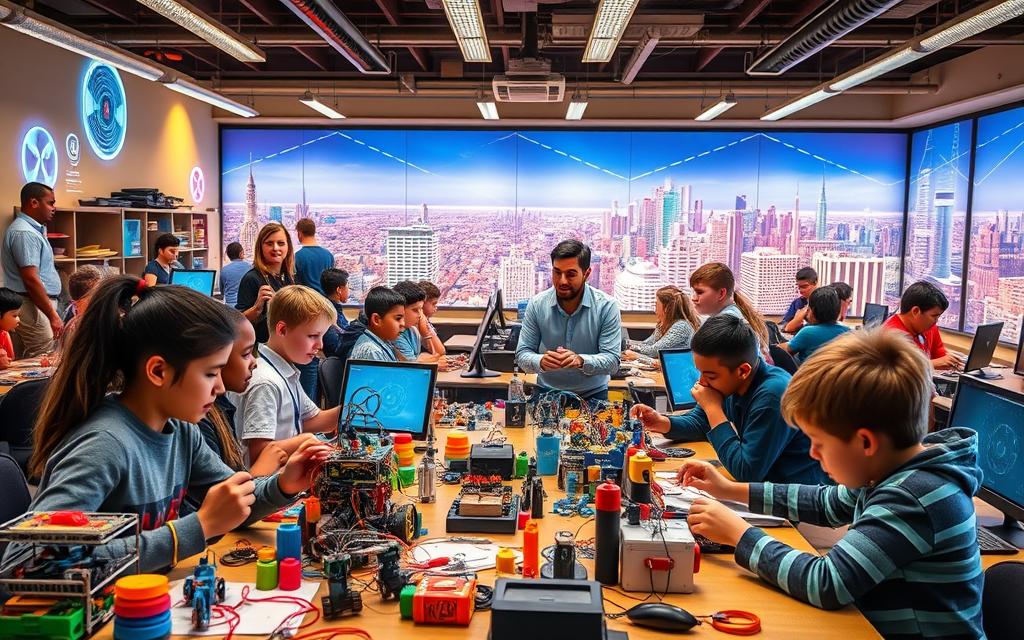Do you know that in the next decade, over 80% of new jobs will need math and science skills? This fact shows the importance of STEM education in readying students for future work challenges. As technology and innovation become key in many fields, STEM programs are crucial for career success.
STEM education helps develop vital skills such as problem-solving, teamwork, and being adaptable. It sparks interest in science, technology, engineering, and math. It also gets the next generation ready to excel in a rapidly changing job market.
What is STEM Education and Why It Matters
STEM education is key in creating the future workforce by combining science, technology, engineering, and math. Understanding definition of STEM helps us see its impact across various sectors. It encourages critical thinking, problem-solving, and innovation, readying students for today’s complex world.
Definition of STEM Education
STEM education brings together science, technology, engineering, and mathematics in an integrated way. It focuses on both the knowledge and how these subjects apply in the real world. Students learn to link theory with actual challenges, improving their adaptability and problem-solving skills.
Importance of STEM in Today’s World
The need for STEM education is huge as the demand for skilled workers in these areas grows. Studies show STEM jobs make up about 24% of the U.S. workforce. These jobs drive innovation and help the economy grow. As technology changes industries, the call for STEM-skilled workers gets louder. It shows how crucial education is in preparing students for future jobs.
The Benefits of Participating in STEM Programs
STEM programs are more than just about learning facts. They help you gain skills, become more creative, and get better at solving problems. These are all important for finding a good job.
Skill Development
STEM helps you build key skills for your career. You’ll learn how to think critically, adapt to change, and work well with others. By figuring out challenges in new ways, you get ready for today’s job world.
Boosting Creativity
In STEM, you get to be curious and think outside the box. It’s all about being creative and coming up with new ideas. Making mistakes and learning from them helps you think of something amazing next time.
Enhancing Problem Solving Abilities
STEM teaches you to handle tough problems, knowing there’s not just one right answer. This skill isn’t just for science or tech jobs. It helps in many fields, from engineering to business management. Getting good at solving problems is key.
| Benefit | Description |
|---|---|
| Skill Development | Fosters critical thinking, adaptability, and teamwork. |
| Boosting Creativity | Encourages curiosity and innovation through experimentation. |
| Problem Solving | Teaches students to find multiple solutions for complex challenges. |
The Growing Need for STEM Professionals
The need for experts in science, technology, engineering, and math is at an all-time high. Industries across the board are leaning more on advancements in these fields. This makes it vital for both job seekers and educators to understand the changes in the job market. The way our workforce is changing highlights how much we need STEM professionals.
Job Market Trends
Recent research shows that businesses are putting more money into tech innovations. This shift is creating a big increase in jobs that need STEM skills. In fields from healthcare to finance, the use of new tech means needing workers who have specific abilities. Employers want people skilled in data analysis, biotechnology, and software development. This matches up with the trends we’re seeing in jobs today.
Projected Growth in STEM Careers
Experts predict that STEM jobs will grow quickly in the next few years. They say that by 2030, many jobs will have to include STEM skills. This will change how the job market looks across different sectors. This shows how crucial it is to focus on STEM education now. Schools and colleges will have to update their programs to prepare for this future job growth.
| Industry | Current Job Growth (%) | Projected Job Growth by 2030 (%) |
|---|---|---|
| Healthcare | 15% | 22% |
| Technology | 12% | 23% |
| Engineering | 10% | 18% |
| Environmental Science | 14% | 20% |
STEM Programs in Schools
STEM programs in schools are changing the way students learn. They combine science, technology, engineering, and math. Students not only learn theory but also get to apply what they learn, making it more fun and useful.
Curriculum Enhancements
Many schools have upgraded their curriculum to make STEM subjects more interesting. Students get their hands dirty with activities like coding or making robots. Working on these projects together helps students understand STEM better and improve their ability to work with others.
Extracurricular Activities
Outside class, schools offer STEM-focused clubs and activities. From robotics clubs to science fairs, students use what they learn in real-world challenges. These activities deepen their interest in STEM and let them highlight their inventiveness and skills.
Community Partnerships
Collaborating with local businesses and groups is key to boosting STEM programs. These partnerships give students mentoring and real-world experiences, linking studies to future jobs. This can open up new opportunities for students and make their STEM education even more valuable.

The Role of Technology in STEM Education
Technology has changed STEM education, making it interactive and easy to get. Digital platforms let teachers meet varied student needs. This change fosters deep understanding of complex ideas through hands-on learning.
Online Learning Resources
Online resources are vital in today’s education. Students can find lots of info and interactive tools outside the classroom. They have access to virtual labs, video lessons, and practice tasks. These help with learning at their own pace. They can dive deep into STEM topics, grow research skills, and become more curious.
Educational Software and Tools
Educational software and tools greatly improve STEM teaching and learning. There are programs for coding, engineering simulations, and analyzing data. They offer fun learning chances for students. Teachers can use these tools for lessons that grab students’ attention and help them understand tough ideas. This use of technology prepares the next generation of thinkers and problem solvers.
How Parents Can Support STEM Learning at Home
Parents are key in inspiring their kids to delve into STEM. By sparking curiosity and offering fun, hands-on learning, they greatly support their education.
Encouraging Curiosity
Starting a passion for STEM means making curiosity a priority. By asking thought-provoking questions and discussing how STEM affects our world, parents can motivate their children. This encourages kids to discover, ask their own questions, and seek solutions. It lays the foundation for a lifetime of learning.
Providing Hands-On Experiences
Doing hands-on projects helps kids see STEM principles in real life. Activities like simple science experiments, building things, or tech tasks make learning concrete and fun. These hands-on experiences not only boost understanding but also link to school lessons. When parents include these activities at home, they boost their kids’ excitement for STEM.
| Activity Type | Examples | Benefits |
|---|---|---|
| Science Experiments | Baking soda volcano, homemade slime | Encourages inquiry and a hands-on approach to learning |
| Building Projects | Lego structures, model rocket kits | Enhances problem-solving skills and promotes creativity |
| Technology Tasks | Coding games, robotics kits | Develops technical skills and understanding of technology in the modern world |
Overcoming Barriers to STEM Education
The path to making STEM subjects open to everyone has big obstacles. The main problems are gender gaps and STEM access. Solving these issues can make a world where everyone can succeed.
Gender Disparities in STEM Fields
There are not enough women in STEM areas, and it’s a big concern. Studies show that girls face many obstacles in chasing STEM careers. Programs for young girls are key to changing this situation. They provide a supporting environment. This helps motivate girls to pursue their STEM dreams. It’s a step towards balancing the gender gap in these important areas.
Accessibility for Underserved Communities
Having access to STEM is vital for fair learning chances. Underserved communities often struggle more to get good STEM education. This is due to issues like not enough resources, few skilled teachers, and little technology. Projects that aim for more inclusivity work to remove these obstacles. They ensure that every kid, no matter their background, has what they need to do well in STEM.
| Challenge | Impact on STEM Education | Potential Solutions |
|---|---|---|
| Gender Disparities | Lower participation and representation of women | Targeted programs for girls, mentorship |
| Accessibility in STEM | Limited access for underserved communities | Equitable resource distribution, community initiatives |
The Impact of STEM Education on Economic Growth
STEM education does more than help individuals succeed. It shapes our economy too. As we dive into more tech, the demand for smart, skilled people grows. This need shows how key STEM education is for economic growth and job competition.
Innovations and Entrepreneurship
STEM education is key for sparking new ideas and businesses. Those with strong STEM skills can create amazing things. They help all sorts of sectors grow, making our economy stronger. Both new and old businesses rely on STEM pros to come up with tech that boosts productivity and life quality.
Workforce Competitiveness
In a world where markets are tough, a solid STEM education matters a lot. Employers want people who are good at STEM. This helps countries keep up as the world changes. Good education systems that meet what jobs need will prepare young people well. They’ll be ready for the future job market.
Future of STEM Education
The future of STEM education is on the brink of big changes. Artificial intelligence and machine learning are leading these changes. They are reshaping how we teach and learn. This means students will really know their stuff and also get skills that today’s jobs need.
To get ready for what’s coming, schools must try new things. It’s key to work together, be ready to change, and learn by doing. Schools should be places where students can be creative and solve problems. This helps them face tomorrow’s challenges and grab new chances.
We must focus on bringing in new ways and always getting better to keep up with STEM education. Strong STEM programs are crucial. They will help future students not just join but lead in a world full of tech.




